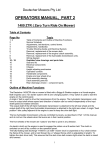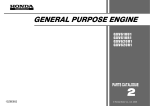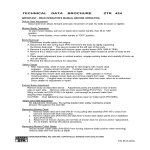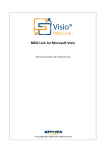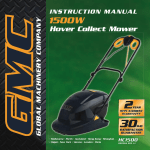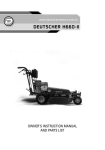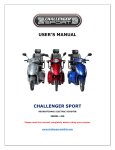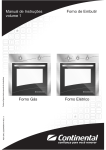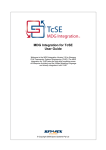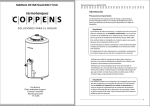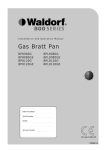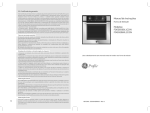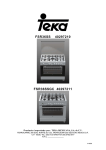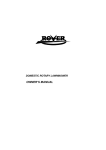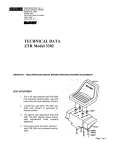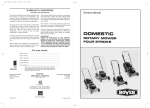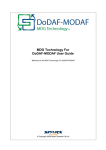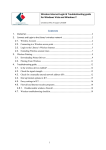Download OPERATORS MANUAL, PART 1
Transcript
Deutscher Mowers Pty Ltd OPERATORS MANUAL, PART 1 1400 ZTR ( Zero Turn Ride On Mower) Mower Serial Number ______________________________ Date Purchased _____________________ Owners Name __________________________ Dealer ________________________________________ Dealer’s Address _______________________________________________________________________ Dealer’s Contact Details, phone, email etc. ___________________________________________________ INTRODUCTION Thankyou for purchasing the Deutscher 1400 ZTR mower. The mower has been manufactured by Deutscher Mowers Pty Ltd of 711, Creswick Rd. Ballarat, Victoria, Australia. We are confident you will appreciate the features, the mowing speed and the durability of this mower. This manual is in two parts. Part 1 contains the operating and safety instructions plus some maintenance operations which can be performed by most owners. Detailed maintenance and parts lists are covered in Part 2. This part would normally be needed by a mechanic or a dealer who performs the routine services. The mower is fitted with an hour meter and a chart in Part 2 gives you recommendations on the type of servicing and the recommended “hours” when that servicing should be performed. Our warranty conditions are written on the last page of Part 1. Please read them carefully. Also, please return the completed registration card which is included with this manual. The purpose of the card is to register each unit at the factory so we can advise you of future product improvements or revised operating and maintenance instructions. In the unlikely event that the mower is sold within the warranty period, the new owner must advise* Deutscher Mowers Pty Ltd in writing of the change of ownership and the mower’s serial number. (*within one week of the sale). Failure to do so will mean we are not obliged to honour the warranty conditions. TABLE OF CONTENTS - Part 1 Page No. Topic 1 Introduction and table of contents 2,3 General safety precautions. 3,4 Specifications and options. 5,6 Controls and safety features. 7,8 Operation and additional safety precautions. 9 Lubrication and maintenance. 9 Trouble shooting, general. 10 Rear Discharge ZTR, additional instructions. 11 Warranty 1 GENERAL SAFETY PRECAUTIONS 1. Know your controls. Read the Operators Manual carefully. Learn how to stop the engine quickly in an emergency, 2. Do not allow children or people unfamiliar with these instructions to use the mower, Do not carry passengers. 3. Make sure the lawn is clear of sticks, stones, bones, wire and debris. They could be thrown by the blade. 4. Do not mow whilst people, especially children, or pets, are in the mowing area. 5. Exercise extreme caution when on slopes. Never mow across the face of a slope. Reduce speed on slopes, especially in sharp turns. Do not start or stop suddenly when going uphill or downhill. 6. Stay alert for holes in the terrain or other hidden hazards. 7. Do not pull loads. 8. Watch out for traffic when crossing or operating the mower near roadways. 9. Stop the blades before crossing surfaces other than grass. 10. Before leaving the operators position, • Disengage the blade drive. • Engage the handbrake by moving the right hand operating lever to it’s OUT position. • Turn off the engine by turning off the key switch, then remove the key. ( A buzzer will sound if you leave the seat without turning off the key.) 11. Stop the engine and turn off the blade switch :• Before refuelling • Before clearing blockages • Before checking, cleaning or working on the mower. • After striking a foreign object. ( inspect the mower for damage and make repairs before restarting and operating the mower. • If machine starts to vibrate abnormally, check immediately. 12. A mower operator should be in good physical and mental health and not under the influence of any drug or alcohol which might impair vision, co-ordination or judgement. 13. Never mow while barefoot or wearing open sandals, or thongs. Wear only long trousers and heavy shoes. 14. It is advisable to wear suitable eye protection and hearing protection when operating a mower. 15. Mow only in good daylight. 16. Before using the mower, always visually inspect the blades, blade bolts and cutter assemblies to ensure they are not worn or damaged. Replace worn or damaged blades and bolts in sets to preserve balance. 17. Check all nuts, bolts and screws often; always be sure the mower is in a safe operating condition. 18. Keep safety devices (guards and switches) in place and in good working order. 2 19. Ensure any spare parts used comply with the original manufacturer’s recommendations and specifications. 20. Replace worn or faulty silencers. 21. Keep engine free of grass, leaves or excessive grease. These can be a fire hazard. 22. Refuel outdoors only. Do not smoke whilst refuelling the engine. Never remove the cap of the fuel tank or add petrol while the engine is running or the engine is hot. Remove the fuel cap slowly to relieve any tank pressure. If petrol is spilled, do not attempt to start the engine but move the machine away from the area of the spill and avoid creating any sources of ignition until the petrol vapours have dissipated. 23. Check for fuel leaks while refuelling or using the mower. If a fuel leak is found, do not start or run the engine until the fuel leak is fixed and the spilled fuel wiped away. 24. Do not operate the mower in a confined space where exhaust fumes (carbon monoxide) can collect. 25. Do not over-speed the engine or alter the governor settings. Excessive speed is dangerous and shortens mower life. 26. Stop the engine whenever you leave the mower, even for a moment. 27. Store the mower in a well ventilated room away from naked flames as may be found in gas hot water heaters. 28. Do not lend or sell the mower without the Owner’s Manual. 29. Wear appropriate protection from the sun, i.e. approved UV reduction glasses, a hat, protective clothing and sunscreen. 30. Be extremely careful when mowing on wet grass, especially on slopes. Lack of traction can cause steering problems and extended braking distances. Similar problems can occur if the mower is driven with very worn tyres. Stop mowing if you notice that traction is limited. 31. Do not touch the hot muffler or the muffler pipes. Keep bystanders away, especially from the rear of the mower. Be aware that the muffler will take over 5 minutes to cool after the mower is stopped. SPECIFICATIONS 1. Serial number. This is located on the decal on your control panel. Please write the number in the front of your Operators Manual in case the number on the mower becomes unreadable. The serial number enables us to determine when the mower was manufactured, and is a vital clue if you need assistance, especially if some parts have been redesigned since yours was made. 2. Decals. The mower is fitted with the decals listed below. Should any of the safety decals become worn or damaged so they cannot be read, it is the responsibility of the owner to replace them, particularly if the mower is loaned or hired to others. • Control Panel Decal including manufacturer’s details and the serial number. • Important Safety Precautions decal. • Discharge chute warning decal. • Badges on rear of mudguards. • 1400ZTR decals. • Arrow decals on the control levers. 3. Width at rear wheels. 710mm. 3 4. Length, including bumper bar. 1859 mm. 5. Mower deck. • Cutting width 1400mm (54”) • Deck width including discharge chute. 1650 mm. • Number of disc blades. 3 • Diameter of discs 335 mm • Blade pitch circle diameter. 485mm. 6. Cutting heights. Lowest 20mm, highest 100mm +/- 10mm. 7. Fuel capacity 16 litres and 32 litres with optional tank fitted. 8. Approximate maximum groundspeed on a hard surface, 12.0 kph. 9. Weight including the deck. 273 Kg 10. Belts. Blade drive (long) Blade drive (short) Wheel drive 11. Tyres. B 88S B 50S AX 61S Rear 20 x 8.00 x 8 (Kenda) Recommended rear tyre pressure 11 psi (76kPa) Front 13 x 5 – 6 Recommended front tyre pressure 18 psi (124 kPa) 12. Battery 12 volt lead acid. 13. Blade clutch. Electric clutch, 12v, 14. Fuel type. Standard unleaded. 15. Hydrostatic transmission 16. Oil type. Hydro-Gear Model 310-2400 Engine. SAE30, Hydrostatic transmission 20W50. Specification Options. 1. Engine. 2. Seats Briggs and Stratton Intek OHV or Honda 20Hp GXV610. Standard P2 KAB with backrest on B&S powered units. U2 KAB seat with armrests on Honda powered units. 3. An adjustable backrest on the standard seat. 4. Fuel tanks, A single 16 litre tank is standard with a toolbox on the left mudguard. Optional, 2 tanks and no toolbox. 5. A “roll over protection bar” can be supplied. WARNING. A roll over protection bar may prevent an injury during a roll over, but it may also cause the mower to tip suddenly backwards if the mower is driven under a tree, which has strong branches below the height of the roll over protection bar. A roll over is highly unlikely if the mower is driven on a slope no greater than 10 degrees to the horizontal and if it is driven in accordance with these instructions. 4 CONTROLS and SAFETY FEATURES Lever lock RH control lever LH control lever Height adjusting pin. Freewheeling levers.( Under cross beam at rear) Pedal pin Hour meter Height adjusting pedal. Footrest Throttle lever Choke lever Blade switch Key switch Control Levers The levers will lock in the “IN” and “OUT” positions. In the sketch above, the Right Hand lever is shown in the OUT position and the Left Hand lever is shown in the IN position. To move a lever from the OUT position to the IN position and vice versa, first raise the lever lock, start moving the lever inwards or outwards and release the lever lock as you do so. The lever will lock in the position it is moved to. When moving to the OUT position, stop moving the lever as soon as you hear the lever lock engage. When the Right Hand lever is in the OUT position, the handbrake is engaged and the blade drive circuit is disengaged. (i.e. the blades will not rotate.) The mower can only be started with the Right Hand lever in the OUT position. For the safety of others and possibly the operator, this control feature ensures that the handbrake is engaged and the blades are disengaged when the mower is started. When the levers are in the IN position, they can be moved forwards and backwards. IMPORTANT. DO not attempt to move the control levers forwards or backwards when they are in the “OUT” position. With the engine running, moving the Left Hand lever forward causes the rear left wheel to rotate forwards. Moving the Left Hand lever backwards causes the rear left wheel to rotate backwards. Similarly, the Right Hand lever controls the rear right wheel. The ground speed forwards and backwards is controlled by the distance the levers are moved and by the throttle setting. When driving in confined spaces or on ramps, use a very low throttle setting and small control movements. There is a forward over-travel spring on both levers. If the levers are pushed forward beyond the control movement of the transmission, a heavy spring will stretch, to protect the control mechanism from being bent. Do not attempt to push the levers further forward once you feel the increased resistance. Footrest The left foot rest can be clamped in a number of positions for comfort. To slide the pedal, loosen the star knob, slide the pedal along and re-tighten the knob. The pedal can be removed when it is moved to the end of either key shaped slot nearest to the operator. 5 Blade Height Adjustment The blade height is controlled by your right foot. When you first sit in the drivers seat, check that the right pedal is in a position where full leg extension achieves the top deck height. To move the pedal on the shaft, withdraw the pedal pin, slide the pedal along the shaft and reinsert the pin. To change the blade height, simply push the pedal to achieve slightly above the desired height and, while maintaining foot pressure, remove the height adjusting pin from the long shaft and relocate it in the hole closest to the seat. Ease off the foot pressure. When approaching obstacles, the deck can be raised momentarily by pushing on the pedal, without removing the height adjusting pin. RELEASE FOOT PRESSURE SLOWLY TO PROLONG THE LIFE OF THE HEIGHT ADJUSTING MECHANISM. Choke Lever Move the lever fully forward when starting a cold engine. As soon as the engine is warm, move the lever to the limit of it’s travel towards the operator’s seat. Blade Switch The blades can be engaged and disengaged by simply switching them on and off. They will automatically disengage if the Right Hand lever is moved to the OUT position, even if the blade switch is on. Key Switch and Seat Buzzer The key switch is similar to a “two position” car switch. Moving it to the first position turns on the circuits, and moving it to the second position momentarily, the starter motor turns the engine over. Turning the key switch to “off” stops the engine. A switch under the operator’s seat automatically shorts out the ignition when no operator is present. This means the starter motor can turn the engine when you are not in the seat, but the engine will not start. If the seat lid is lifted, another switch prevents the engine being turned over. THIS DOES NOT MEAN YOU SHOULD RELY ON THE SWITCHES. ALWAYS TURN OFF THE IGNITION AND REMOVE THE KEY BEFORE LEAVING THE MACHINE OR LIFTING THE SEAT LID. When the mower is running, the engine will stop if you leave the seat. A buzzer will also sound if you leave the seat without turning off the key. This feature is to prevent the battery becoming flat, as a solenoid in the engine continues to draw power while the key switch is on. PASSENGERS MUST NOT BE CARRIED. THEY ARE NOT PROTECTED BY THE SEAT SWITCH. CHILDREN HAVE HAD SEVERE FOOT INJURIES WHEN TRAVELLING AS PASSENGERS ON RIDE ON MOWERS AND THEN ALIGHTING OR FALLING FROM THEM. Throttle lever Moving the lever forward achieves full throttle. Fully backwards, the engine idles. Hour Meter The hour meter operates when the ignition switch is on. The reading is used to tell when routine servicing is required. Freewheeling Levers The two levers at the rear of the machine are normally fully in. If you need to push the machine without the engine running, pull the levers fully out then down. They will lock in that position. Before pushing the mower, release the hand brake by putting the Right Hand lever to the IN position. DO NOT ATTEMPT THIS ON SLOPES. Note. The machine cannot be driven with the freewheeling levers in their “out” position. 6 OPERATION and ADDITIONAL SAFETY FEATURES Before Starting 1. Read the whole of this manual, Part 1. 2. Check the oil level in the engine and check that there is sufficient fuel in the fuel tank. 3. Check the area to be mowed for debris. 4. Ensure that bystanders are kept well away. 5. For extended use, use hearing protection. 6. Check that the mower blades are firmly attached and in good condition. 7. Check that the discharge chute is in place and not damaged. 8. DO NOT ATTEMPT TO MOW AN AREA WHICH IS SLOPING MORE THAN 10 degrees TO THE HORIZONTAL. i.e One in Four. Starting 1. Before climbing onto the mower, move the control levers to the “OUT” position. See Page 5. 2. Sit in the seat and check the position of the footrest and the height adjusting pedal. Move them if necessary. If the seat is fitted with armrests, these are also adjustable using a dial under the front of each armrest. 3. Push the choke lever to “ON” and set the throttle to a mid position. Note. It should not be necessary to use the choke if the engine is hot. 4. Ensure the blade switch is off. 5. Insert the key in the key switch and turn the key fully clockwise. Release clockwise pressure on the key as soon as the engine fires. 6. After the engine starts, slowly move the choke to the off position. 7. Lift the lever locks on the right and left hand control levers and allow the levers to move to the “IN” position. SAFETY NOTE. Be especially careful if starting on a slope, as moving the right hand lever inwards disconnects the parking brake. The “hydro” control with the levers in neutral acts like a handbrake, but touching the levers will result in instant movement. Also, the hydro will not act as a brake if the freewheeling levers at the rear of the machine have been engaged. If you find yourself rolling down a slope because the freewheeling levers have been engaged, unlock the right control lever and move it to the “OUT” position. WARNING. Never push the control levers forwards or backwards when they are in the “OUT” position. This could damage the hydrostatic drive units, particularly the handbrake components. DO NOT USE THE LEVERS TO ASSIST IN LEAVING THE SEAT. Moving.( First time user.) 1. Practice manoeuvring in an open area with the blade switch turned off and the deck raised well above the ground. Leave the throttle on a low setting until you are familiar with the function of the controls. ENSURE BYSTANDERS ARE WELL CLEAR. 2. Ease both levers forward a small amount and then release them. Now move them both towards you a small amount then release them. The mower will go forward then backward. 3. Next move the right lever a small distance forward and then a small distance rearward, while not engaging the left control. Try the same action with the left control. This demonstrates that the right lever controls the right rear wheel and the left lever controls the left rear wheel. 4. Now move the right lever a small distance forward and the left lever a small distance rearward. The mower should turn anticlockwise in its own length. 5. Practice the above manoeuvres until you can confidently move in a straight line and turn on the spot. 6. To travel in a left hand curve, simply move the right hand lever further forward than the left hand lever. This makes the right rear wheel rotate faster than the left rear wheel. For a right hand curve, move the left lever further forward than the right lever. 7 7. Once you are fully competent manoeuvring at slow speed, increase the throttle setting and use larger lever movements. NOTE. The control levers are fitted with an over-travel spring in the forward direction. Stop moving the levers forward when you feel a significant increase in resistance. Further movement will not result in greater speed and may damage the control mechanism. Normal Mowing Before mowing, clear the area to be mowed of debris. 1. Drive to the area you are about to mow with the deck raised and the blade switched off. 2. Once you are on the grass, lower the deck to the height you wish to use for cutting and turn on the blade switch. 3. Move forward and start cutting. In long grass, use a higher deck setting and a slower forward speed. 4. If you become aware of a loss of traction due to wet grass, excessive slopes or faulty tyres, stop mowing. A loss of traction with a ZTR can cause steering problems as well as extending the braking distance. 5. In general, mow with the discharge chute throwing grass onto the area already cut. i.e. in large areas, mow in anticlockwise rectangles (always turning left). 6. Also turn left around trees, as the left side of the deck is shaped to enable a close cut. 7. Along fences, run the left side of the deck near the fence for a closer cut. 8. When obstacles such as hoses are encountered, you can raise the deck by pushing on the foot pedal before you pass over the obstacle. Release the lever slowly after you pass over the obstacle. If there is any possibility of the blades hitting the obstacle, turn them off first. Note. Releasing the deck back to its original position slowly will reduce shock loads and reduce wear on the height adjusting mechanism. Mowing on Slopes 1. As mentioned above, do not attempt to mow a site with a slope greater than 10 degrees to the horizontal. 2. Do not accelerate or decelerate quickly when driving on slopes. 3. Do not mow across steep slopes. 4. Turn slowly. 5. Reduce speed. 6. Stop mowing if you are losing traction. Stopping 1. Drive to the area you intend to park the mower with the blades turned off, the deck raised and the engine on a low throttle setting. 2. Turn off the key switch once the mower is parked. 3. Remove the key from the key switch. 4. Put both control levers in the “OUT” position and dismount. Note. If you leave the seat without turning off the engine, the engine will stop automatically and a buzzer will sound. The buzzer is a warning signal to tell you that the battery will become flattened unless the key switch is turned off. Ascending and descending narrow ramps 1. This should only be attempted by people who feel competent driving the mower. 2. Raise the deck to its full height. 3. Put the throttle to idle and use extremely small control lever movements. Practice driving very slowly on the ground if you are unsure. 4. Do not make sudden control movements. The front of the mower can move sideways very quickly. 5. If the deck is removed, ONLY ASCEND RAMPS BACKWARDS. 8 LUBRICATION and MAINTENANCE GENERAL Note. For detailed maintenance, see Part 2. Fuel Standard unleaded fuel is recommended. See also the engine booklet supplied with the mower. DO NOT ADD OIL TO THE FUEL. Preferably empty the tank if the mower is to be left for many weeks, and use fresh fuel when starting the next time. Engine Oil See the engine booklet. The engine oil level should be checked every 5 hours of operation, and topped up if necessary. Use the oil recommended in the engine booklet. It may be wise to keep a log book, using the readings from the hour meter on the operator’s panel. Change the oil when recommended by the manufacture, generally every 50 hours of operation. Hydrostatic Transmission. The Hydro-Gear model 310-2400 units fitted to your mower are factory filled and do not usually require maintenance. They use 20W50 engine oil. A specific air gap is required inside the transmission to allow for expansion. The unit should only be filled by trained service personnel. Battery Regularly check the water level in the battery as you would in a car, and top up with distilled water to a level slightly above the plates, if necessary. SAFETY WARNING. Wear rubber gloves and safety goggles when topping up a battery. If you are splashed with acid, wash the affected areas with copious amounts of water, then see a doctor. Belts The 1400 ZTR has three belts driving the blades and one belt driving the Hydro-Gear transmission units. If the belts are noisy or if there is obvious belt slip occurring, see Part 2 for belt adjustment. Replace badly worn or damaged belts. Lubricating Oil At regular intervals, the following pivot points may be oiled with a light oil to reduce wear. • Seat hinges and battery lid hinges • Pivot bolt on right angled lever above the hydro units. (Located under the battery access lid and on either side of the chassis.) • The handbrake mechanism pivots. Also under the battery access lid. Basic Troubleshooting Chart SYMPTOM POSSIBLE CAUSE • • • • • • Right hand lever in “IN” position. Flat battery. Battery access lid lifted. Choke not on. No fuel Operator not sitting on the seat. Engine runs but the blades will not engage. • • • Right hand lever in the “OUT” position. Blade switch off. Blade belt not connected or loose. Engine runs but mower will not drive forward. • • • Hydro drive belt slipping or broken. Freewheeling levers in “out” position. Right hand lever in “OUT” position. • Belts need replacing or adjusting. See Part 2 of this manual. Excessively long grass and too low a cut height or too high a forward speed. Engine will not turn over when key switch operated. Engine will turn over but will not start. Drive belts or blade belts noisy or there is obvious slip occurring. • 9 DEUTSCHER Rear Discharge ZTR, Model No 36391 Additional Specifications and Instructions Specifications • • • • • Width of cut, 1400mm (54”) Cutting height, Lowest 20mm, highest 90mm Engine, Honda 20 Hp GXV 620 K1QAF Air cleaner – Heavy duty remote cyclonic type. Grass discharge. All material is discharged out the rear of the mower, between the rear wheels. General Comments Rear–discharge mowers are inherently safer than side discharge units and are keenly sought by those operators mowing in public environments. A rear discharge mower allows the debris to be discharged out the rear of the machine instead of out the side and onto roads, footpaths, flowerbeds and monuments. This allows the operator to mow close to objects on both sides. Mowing There is no significant difference in mowing technique or safety precautions between the rear discharge ZTR and the side discharge ZTR. However, please be aware that any thrown objects are likely to be discharged out the rear of the mower, rather than to the side. Maintenance Regularly check the compartment under the seat for grass “build-up” on the hydrostatic transmission units. Wash the area clear if grass build-up is observed. In dusty conditions ensure the air cleaner is serviced regularly. To ensure correct operation of the mowing deck, periodically check that the guides welded above the disc blades are securely in position and not bent out of shape from contact with foreign objects. Check regularly that all blades and blade bolts are not worn or damaged. See Part 2, page 19, for component part details of the rear discharge version. 10 Deutscher Mowers Pty Ltd reserves the right to change specifications, add improvements or discontinue the manufacture of any of its equipment without notice or obligation to purchasers of its equipment. Deutscher Mowers warranty will be voided if unapproved attachments are adapted and used on the Deutscher Mowers equipment. The responsibility for the design, performance, durability, safety and warranty of the adapted equipment remains with the original manufacturer. LIMITED WARRANTY All new Deutscher Mowers equipment is warranted to the original purchaser only (unless agreed otherwise in writing), to be free from defects in material and workmanship under normal use and service for a period of one year from the date of purchase. This warranty does not apply to engines and hydrostatic transmissions manufactured by Briggs and Stratton and Honda. Warranties with respect to these components are provided by their respective manufacturer and copies of their warranties are supplied with each new Deutscher Mower product. Deutscher Mower’s obligation under this warranty is limited to the repair or replacement, at its option by an authorised Deutscher Mower dealer, of any part found to be defective in material or workmanship without charge for parts or labour. In order to obtain warranty service, the owner is responsible for: • Providing proof of purchase documents, ownership registration or copy of a bill of sale. • Informing any authorised Deutscher Mowers equipment dealer of the defect and making the product available for repair. (Charges for pick-up, delivery and service calls are not covered by this warranty.) This warranty does not cover defects, malfunctions or failures caused by : • Use of unauthorised accessories or attachments. • Lack of reasonable and necessary maintenance as specified in the Operators Manual Part1 and Part 2. • Misuse, accidents or normal wear. • Activities not in accordance with these Operating Instructions. DISCLAIMER OF CONSEQUENTIAL DAMAGES : DEUTSCHER MOWERS PTY LTD SHALL NOT BE LIABLE UNDER ANY CIRCUMSTANCES FOR ANY INCIDENTAL OR CONSEQUENTIAL DAMAGES OR EXPENSE OF ANY KIND, INCLUDING BUT NOT LIMITED TO COST OF EQUIPMENT RENTAL, LOSS OF PROFITS OR COST OF HIRING SERVICES TO PERFORM TASKS NORMALLY PERFORMED BY THE EQUIPMENT. LIMITATION OF IMPLIED WARRANTIES : ANY IMPLIED WARRANTIES, INCLUDING WITHOUT LIMITATION ANY IMPLIED WARRANTY OF MERCHANTABILITY OR FITNESS FOR A PARTICULAR PURPOSE SHALL BE LIMITED IN DURATION TO A PERIOD OF ONE YEAR FROM THE DATE OF SALE. Deutscher Mowers Pty Ltd 711 Creswick Rd Ballarat, Victoria Australia 11











